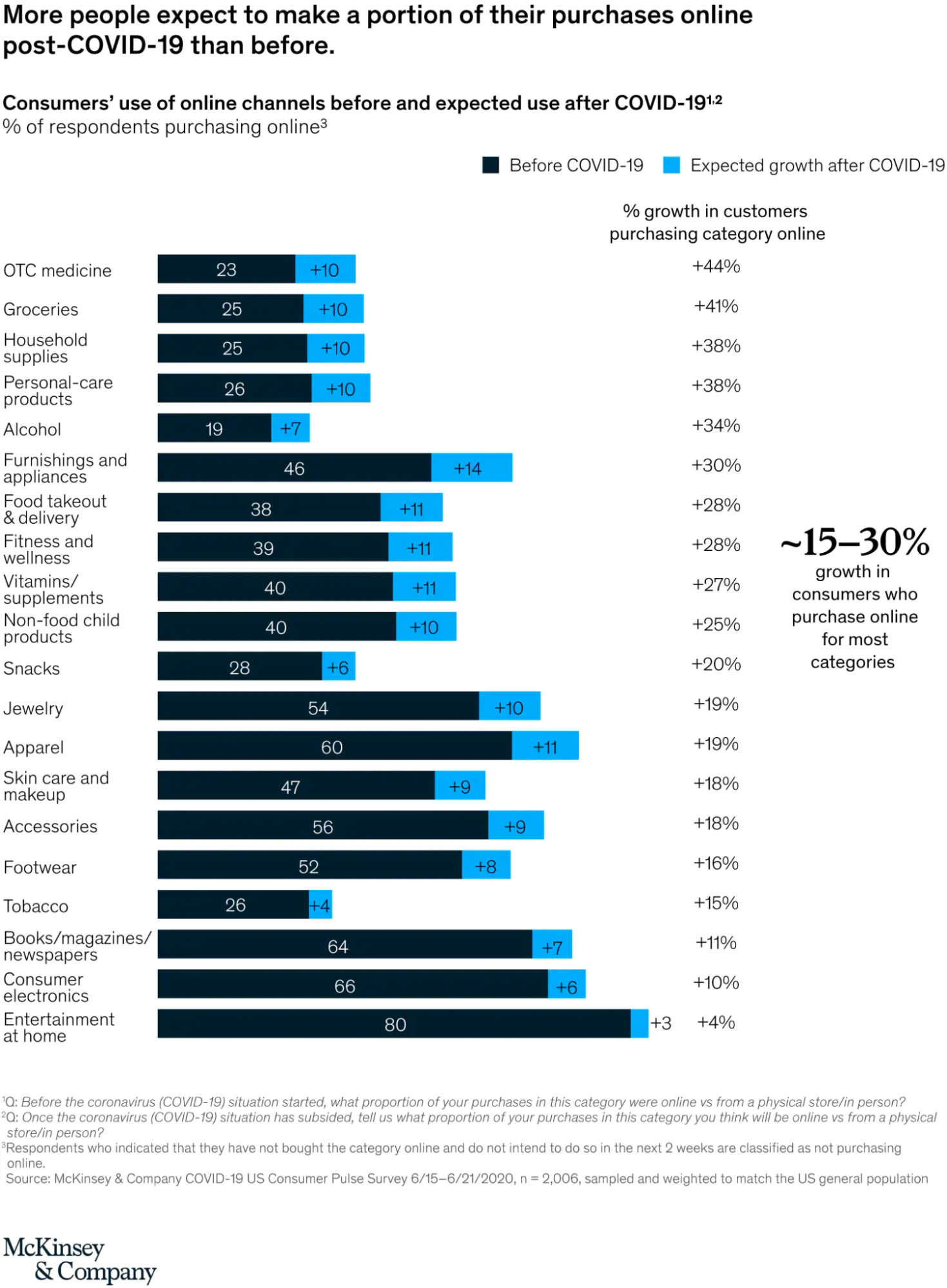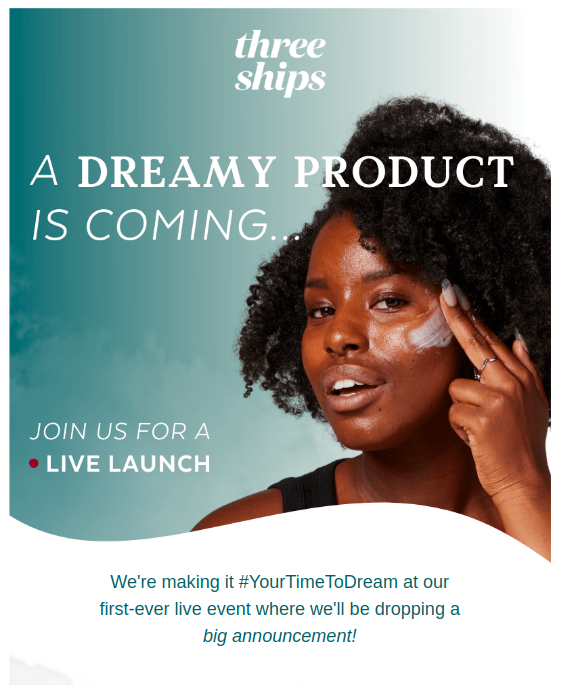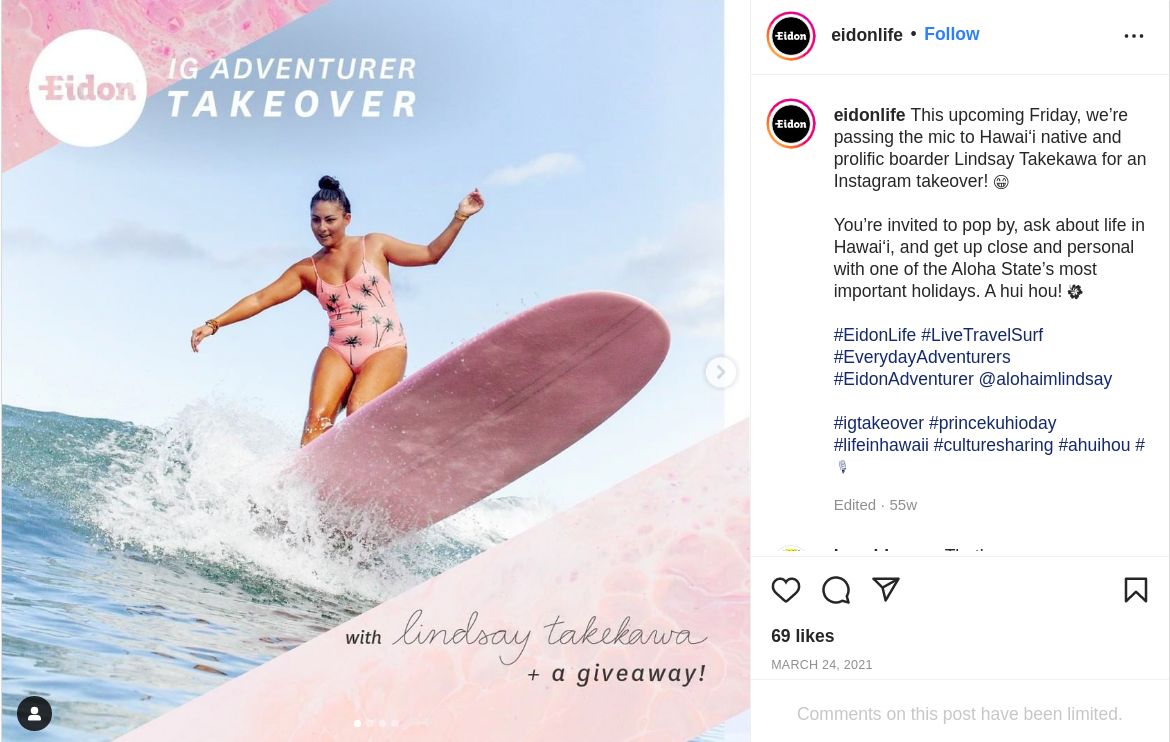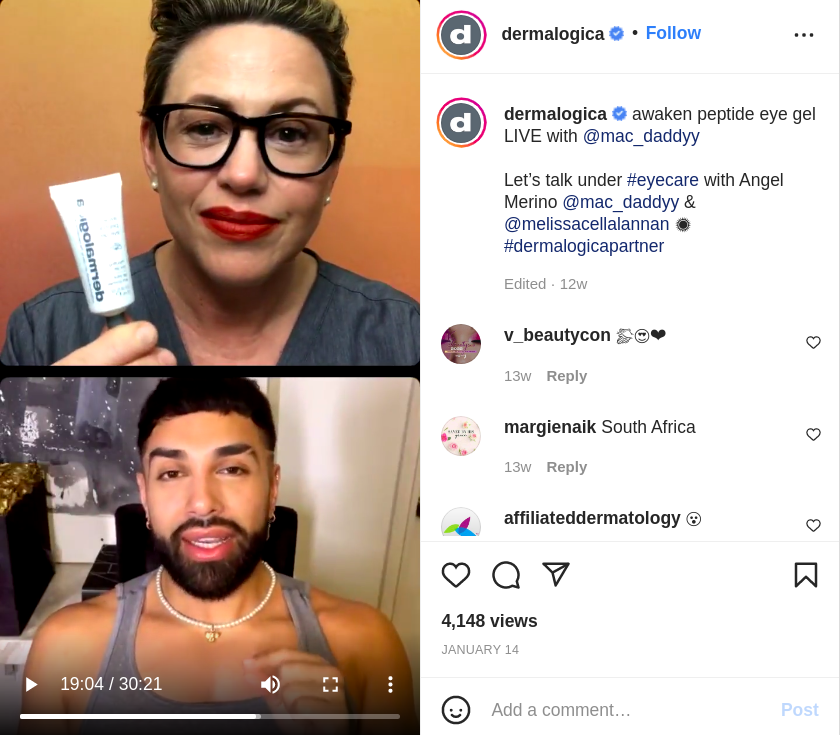The retail industry was in the midst of transformation well before the pandemic.
Customers were already craving more engaging online shopping experiences—and the pandemic only accelerated this, with an astonishing 75% of U.S. consumers trying new shopping methods in response to economic pressure, store closings, and changing priorities during the pandemic (according to McKinsey).

In response to these shifting consumer preferences, live selling has emerged as a way for retailers to engage buyers in a safe, digital format that retains the human element of in-person shopping.
What is live selling?
Live selling (also referred to as live shopping) is the practice of retailers showcasing their products through livestreams (usually via social media), allowing customers to buy products in real-time.
A large component of this format is entertaining, educational, and informative content, such as try-on demonstrations or tutorials.
“Instead of going on QVC or Facebook Live just talking about the attributes or ingredients of your product, focus on how it’s going to make the customer’s life better," shared Sarah Moret, Founder and CEO at Curie. "Focusing on problem and solution is the most important thing if you’re doing live selling.”
Live selling isn’t a new concept: platforms like HSN or QVC have been live selling products in real-time for decades. But why is it becoming more popular now?
Live selling democratizes an experience that traditionally was only available through large media platforms, making it more accessible to smaller brands.
The recent uptick in interest around live selling began in China, where live commerce reached an estimated $171 billion in value in 2020, according to McKinsey.
The U.S. livestream commerce market is starting to pick up steam, and it’s projected by Coresight Research. to hit $25 billion by 2023.
Focusing on problem and solution is the most important thing if you’re doing live selling.
7 benefits of live selling for retailers
Live streaming has the potential to revolutionize the retail industry. The convergence of video and retail is gaining traction, especially among digitally native generations.
YPulse found that while only 34% of Gen Z said they were interested in shoppable livestreams in 2020, that number jumped to more than half in 2021.
Including live selling as part of your retail strategy allows you to:
- Engage with your audience. The best way to build a loyal customer base is to connect and engage customers with regular communication–which live commerce enables.
- Allow customers to make a real-time purchase. Customers want instant gratification, and live selling is the right tool for it.
- Create a personal relationship with your customers. Live streaming can help you leverage the online shopping experience while retaining the human element of in-person commerce.
- Lower your return rates. According to Coresight data, live shoppers are 40% less likely to return an item than other online shoppers.
- Scale your business. Once you set up the infrastructure for live selling, you can easily upscale your business and reach a broader audience.
- Stand out from your competitors. While it’s proven to bring great results, live streaming is still not widely adopted, which makes it a great way to stand out from the crowd.
- Boost your conversion rates. Conversion rates are as high as 40%, according to Mary Ghahremani, CEO of live video shopping platform provider Bambuser.
Live selling platforms: Social media, third-party networks, or owned channels?
Retail giants are bullish on live selling. While some have partnered with mainstream social media platforms such as Walmart with TikTok and Sephora with Facebook, others have created their own channels.

Image Source: Meta
This has advantages—you don’t need an enormous media presence to get started with live selling. While social media and dedicated live selling platforms give you access to a broad audience, having your own channel allows you to capture data, emphasize branding, and repurpose content later.
Live selling on social media
Social media platforms have recognized the huge potential of live selling, and are bulking up their live-streaming capabilities and adding shoppable features.
Facebook, for example, has introduced ‘Live Shopping Fridays.’ During these events, big beauty, skincare, and fashion events live-stream content on a weekly basis. Instagram also recently launched live shopping, allowing businesses to sell products directly from the app, instantly interact with viewers, and engage with potential customers in real time.
TikTok moved further into ecommerce by rolling out a live shopping feature that allows brands to seamlessly integrate products from their TikTok Shopping experience into a live session. YouTube also tapped into the trend by testing shopping via live streams with selected creators.
Live selling through third-party networks
Another approach is using dedicated livestream shopping apps, where customers sign up to watch live broadcasts hosted by independent sellers or influencers. During the streams, they can purchase items, ask questions, and leave feedback in real time.
Livestream shopping is on a quest to become mainstream. According to TechCrunch, startups like Bambuser, Popshop Live, Talkshoplive, Whatnot, and others have raised multimillion-dollar rounds of investment in their live shopping businesses.
Live selling through owned channels
If you decide you want to own the live selling experience, platforms like LiveScale can help you create awareness, engagement, and sales with a fully integrated shopping experience. Brands like Knix, Nerdy Nuts, FEED, and Dermalogica have chosen this path.
Channelize.io is another platform that allows brands to grow their business with livestream shopping. It also has a plugin that enables the multistreaming of live shopping shows on Facebook, Twitch, and YouTube.
9 live selling best practices and real-life examples
If you’re looking for ways to get started with live selling, here are nine best practices and real-life examples (some retail and some ecommerce) to help reinvent your shopping experience.
1. Use live selling for pre-launch promotion
Three Ships Beauty sells vegan & cruelty-free natural skincare products. Looking for ways to bring their in-person event experience online, they tested live selling, promoting a new product—a Dream Night Cream—even before they launched it on their website.

Image source: Milled
Saying the pre-launch strategy was a success is an understatement. During the event, they had 1,200 unique viewers, 356 orders in one hour, and a 26% conversion rate. Using live selling for the pre-launch brought Three Ships Beauty $25k in one hour.
If you’re launching a new product, consider adding live selling to your pre-launch marketing mix. It will help you drive interest, boost engagement, and increase sales.
💡 PRO TIP: With Shopify POS, you can accept exchanges for purchases made online or at another store location and your inventory will be updated instantly–no manual reconciliation required.
2. Create a community
Lola Getts is a female-run "plus centric" activewear brand that offers premium-quality leggings, bras, shorts, and tanks. Knowing that online shopping for plus-size women can be a daunting and exhausting task, Lola Getts hosts live shopping events designed to help customers find the best fit in an up-close-and-personal experience.

Image source: Milled
With live shopping, Lola Getts gives plus-sized women a safe, comfortable space to shop for activewear. If you're a brick-and-mortar merchant, consider giving your customers this option via live selling, too.
This new chapter of commerce is all about having a strong end engaged community. With live streaming, you can enjoy a closer relationship with your target audience and make them feel like part of a community.
3. Move to owned live shopping
Beekman 1802 provides natural alternatives to everything from facial serum to fabric softener, using pure ingredients like goat's milk and botanicals. The brand has sold millions of products to loyal fans since 2018, broadcasting through QVC and HSN.
The Beekman 1802 team decided to use its expertise and host their own Live Shopping event, powered by Livescale.

Image source: Livescale
Beekman 1802 witnessed record-breaking sales, with a 49% engagement rate and a 34.5% sales conversion rate, approximately three times Livescale’s average. These results were achieved organically, without any paid ads or influencer marketing.
Again, if live selling resonates with your audience, consider having your own live selling channel. The flexibility and freedom in terms of content and duration can offer great possibilities for your brand. On top of that, the data you gather allows you to adapt and improve from one event to the next one.
4. Leverage the power of influencers
Glamnetic is a DTC beauty brand popular for its Magnetic lashes, which can also be found in retail stores like Sephora and Ulta. The brand’s social channels started with founder and CEO Ann McFerran explaining how the product worked and how it was different from competitors. Today the brand has a loyal online audience—the Glam Fam.
Thanks to their strong social media following, Glamnetic is going all-in on live shopping, collaborating with well-known makeup artists and influencers. Glamnetic now has a Head of Live Shopping, and, according to Ann McFerran, they are setting up multiple Facebook Lives daily.

Image source: Glamnetic
Including influencers in your live streams is a great way to boost engagement. Influencers already have active social media followings, so this approach can help you tap into that audience as well.
5. Capture emails before the live selling event
Misha Hawaii is a women's jewelry collection that includes exotic pearl strands and rare pearls. In addition to regularly hosting live events on Instagram and Facebook, Misha Hawaii has created a dedicated list for their live shopping events.

Image source: Twitter
Customers who join the community get exclusive deals and a chance to win the daily giveaway. In return, Misha Hawaii captures emails in advance of its live sales, getting the opportunity to engage with its audience before every live event.
If you’re dipping your toe into live selling, consider building a dedicated email list upfront. This will allow you to engage and excite customers for the upcoming event.
6. Use live giveaways to boost the reach
Eidon Swim is a North American surf lifestyle brand on a mission to create a community for adventurous women through colorful, surf-friendly swimsuits. The brand combined live selling, influencer marketing, and live giveaway during their “adventure takeover” Instagram event.

Image source: Eidon Swim
The results were mind-blowing—sales increased 318% from the day before, and they reached nearly 19,000 people on Instagram.
“The brands who do live selling best use it as an opportunity to reward those who join for doing so and for being engaged. Sharing exclusive access links to products, offering limited-time discounts just while the live session is happening, asking those who join to play a part in future designs—anything that acknowledges that the participants took the time to tune in live differentiates the experience from shopping the brand via other channels," said Melissa Minkow, retail commentator and futurist for CI&T. "Consumers see brands' social channels as a personable extension of the brand, so live selling that validates that perception is key.”
If you’re just starting out with live selling, to spark interest, make sure to offer exclusive deals for customers who join. Live giveaways, limited-time discounts or free shipping are just some of the ways to boost excitement.
Consumers see brands' social channels as a personable extension of the brand, so live selling that validates that perception is key.
7. Engage customers to get traction
Sozy is a female-founded clothing brand based in California. They enhanced their live selling experience by streaming try-ons for new products and selling them in real time.
To engage customers, they encouraged them to write “SOLD” in the comments to begin transactions. This resulted in thousands of views and engagements.

Image source: Sozy
“The best tip I have for crushing live selling is to create a strong email and SMS program," said Sam Mendelsohn, CMO at Sozy. "When going live, promote it to your audience via those channels to boost attendance. People love watching lives and seeing the product in action.”
Asking customers to participate by commenting or asking questions during the live stream is another way to make customers feel like they’re actively involved and ultimately increase sales. This is also a fantastic way to easily engage and involve customers who can't attend in-person store events.
8. Scale sales via live stream shopping
Moov Activewear is an environmentally friendly women’s activewear brand focused on movement, innovation, and the desire to do better for the environment. The human connection and personal touch in live video shopping allowed Moov Activewear to transform the way they engage with their customers online and grow sales.

Image source: Channelize.io
According to Channelize.io, the brand has achieved a 63% live engagement rate. Additionally, Moov Activewear saw over 80 purchases throughout all of their live shopping shows.
Use the power of live selling to personalize and humanize the buying experience. Live-stream shopping comes with a dose of the personal touch that online shopping is missing; adding this channel to your marketing mix can help you connect with customers and upscale online and offline sales. Bonus: Purchases made via live selling are great candidates for in-store pickup.
💡 PRO TIP: Offering in-store pickup as a delivery method at checkout is a great way to get more online shoppers to visit your store. To get started, enable in-store pickup availability in Shopify admin to show online shoppers whether a product is available for pickup at one of your stores.
9. Embrace shoppable streaming across platforms
Dermalogica is a professional-grade skin care brand founded by a skin therapist. What makes its approach different is that they have been hosting live streams on platforms like Vimeo and Bambuser, as well as shoppable Instagram live streams.

Image source: Dermatologica
Dermalogica mixes up as many variables as possible to see what works, what gets the most traffic, the best conversion, and the most value, so they can double down on it.
The best way to see what resonates with your audience is to test different live selling channels and platforms. Results from each new live streaming event will help you optimize and improve the next one.
Pivot your retail business toward future growth with live selling
Online streaming is slowly becoming the new home shopping network for Gen Z—even for brands with a brick-and-mortar presence. Piggybacking on this trend can give you a significant first-mover advantage in your niche and help utilize both online and offline tactics to boost sales.
Who knows? Selling your products live online may be the best way to build trust with your customers and bring them into your store.
Read more
- Augmented Reality in Retail: How Retailers are Using AR for Better Shopping Experiences
- 10 Low-Key Things Retailers Can Do To Get Ready for the Year Ahead
- How to Build Your Own Homemade Business With Craft Kits
- Why Retailers Can’t Ignore The Power Of Sound: Building a Sonic Strategy for Your Store
- Retailing in a Recession (+ 8 Tips to Stay Competitive)
- Why People Buy: 5 Aspirational Marketing Tactics for Retail Brands





